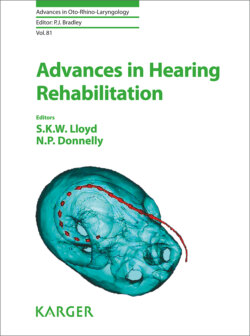Читать книгу Advances in Hearing Rehabilitation - Группа авторов - Страница 49
На сайте Литреса книга снята с продажи.
Skin-Drive Devices
ОглавлениеThe Sophono implant (Medtronic) comprises of 2 magnets encased in a titanium frame. These are secured via 5 screws to the temporal bone after drilling a bony well for the frame to sit in. No percutaneous abutment is present and sound is instead transferred via transcutaneous energy transfer, which is designed to minimize the attenuation caused by the skin between the implant and processor (attached via magnetic attraction) [13]. Studies of twenty patients with congenital unilateral and bilateral canal atresia, have evaluated outcomes from the Sophono device and found that free-field pure tone audiometry (PTA) increased by 28.6 dB [14]. There was also a 61.6% improvement in free-field speech testing (at 65 dB). A case series of 18 patients found that audiological benefits were greatest for those with bilateral CHL (21.9 dB), in comparison to those with a mixed hearing loss who had a relatively moderate gain of 5.5 dB [15].
The BAHA Attract system uses the same titanium implant as the percutaneous system, but instead of an abutment, a magnetic disk is attached subcutaneously. The external sound processor is then attached via the magnet. The recommended maximum bone conduction threshold is 30 dB for the Attract system. A multicenter case series of 27 patients fitted with the Attract system (17 with CHL, 10 with SSD), found a 17.9 dB improvement in PTA in those with CHL, and a 19.1 dB improvement in patients with SSD (although the non-test ear was blocked) [16]. No significant difference was found in PTA when compared to Softband. However, speech understanding in noise was found to improve by 15 dB over the unaided condition and 3.8 dB compared to Softband testing. The abbreviated profile of hearing aid benefit questionnaire showed significant improvements in the background noise domain, the reverberation domain as well as the global score. Two of the 27 patients reported mild/moderate pain after a long period of use, and 4 had mild erythema over the magnet site which resolved over time (one requiring a weaker magnet).
